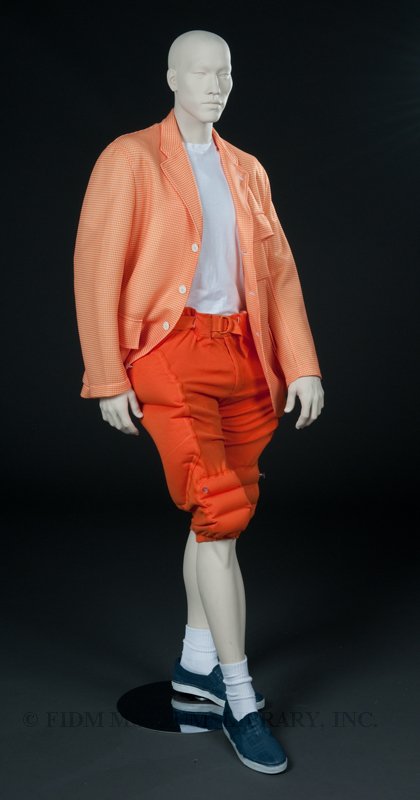Football fashion
Fashion draws its influences from an incredible array of sources--from ancient civilizations to the signs of the zodiac. With Super Bowl XLIX taking place this weekend, we wondered if any of the garments in our collection were influenced by football. Lo and behold, a man's ensemble inspired by football uniforms comes from an unexpected source: Issey Miyake. Known for his experimental aesthetic, it seems unlikely that Miyake would be interested in this mainstream American sport. Before you dismiss the connection, take a minute to visualize the extreme silhouette of a football player fully dressed for a game. Bulky and protected, a geared-up player is almost unrecognizable as an ordinary human. It is this imposing silhouette that influenced the orange Issey Miyake ensemble pictured here.

Suit
Spring/Summer 2001
Issey Miyake
Museum Purchase
2003.5.7AB
Issey Miyake (b. 1938) learned impeccable dressmaking skills at the Ecole de la Chambre Syndicale de la Couture Parisienne in 1965. Yet in the wake of the decade's mounting social discord and political unrest, he came to believe that the bastion of haute couture was no longer relevant to postmodern lifestyles. Miyake opened his Tokyo design studio in 1970, focused on creating ready-to-wear clothing. "Sometimes my clothes are radical, probably sometimes challenging, but I try not to fear radical things," he explained.1
Miyake's Spring/Summer 2001 menswear collection was termed "Pneumatic pret-a-porter" by the fashion press due to the air-filled padding built into many of the garments. This vivid ensemble was inspired by American football uniforms. The blazer is constructed of printed nylon mesh generally reserved for team jerseys; the knickers contain inflatable plastic bladders inserted over the outer thighs and knees to mimic players' protective gear. The clothing morphs the wearer's body into that of a sports hero, enlarging his frame into an imposing physique while cushioning it to withstand the blows of stressful urban living.
1 Wilcox, Claire. Radical Fashion (London: Victoria & Albert Museum, 2001), 112.